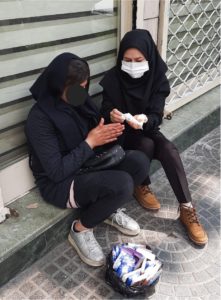Working Children and coronavirus
Not only is 12 June World Day Against Child Labour, but 2021 has been designated as the International Year for the Elimination of Child Labour, To mark this important event, the International Labour Organisation is organising a Week of Action. As part of this, ICN brings you a story of nurses in Iran caring for child labourers working on the streets of Tehran during the COVID-19 pandemic. #EndChildLabour2021
Dr Haleh Jafari is a nurse who works in a hospital, but for many years, she has also been helping working children on the streets of Tehran.
In Iran, the phenomenon of child labour has expanded in most metropolitan areas over the past decades and has caused considerable damage to these children. Child labour is an involuntary economic activity that may include selling flowers, facial tissues, and poetry on the street, cleaning car windows, collecting garbage, working in workshops, etc. None of this work is voluntary and is imposed on children and adolescents due to family issues and economic needs, and causes a lot of physical, emotional and social harm to children and adolescents.
These child labourers have difficulty accessing healthcare services, and are often exposed to physical and sexual abuse, and drugs. It has been reported that the mortality rate among these children is nine to 31 times more than expected (Abdi et al. 2016).
Dr Jafari regularly visits the children, in school or on the streets, and teaches them about health issues. As a nurse, she screens them for health and illness, collects donations for health problems, and refers sick children to the relevant centres.
When the COVID-19 pandemic arrived and the city went into lockdown, many of the children had no choice but to continue to work to support themselves and their families.
With the support of people in Tehran, Dr Jafari was able to distribute disinfectant gels, masks and gloves to the children and their families, and to check on their welfare. She also taught them about the virus and ways to prevent infection through schools or on the street.
Dr Jafari says, “I was both happy to see them again and sad to see they work in those corona days. I knew which parts of the city I could find them. We have lived together in many streets of Tehran. I went and saw them, I asked about their days, their kind of war with Corona, I gave them the equipment that had been provided and trained them as much as I could. We spent a lot of time talking together.”
Having cared for these working children for years, Dr Jafari says, ”The scale of my work may not be very large, but as soon as we can educate even a child and a family, save someone from illness, give someone hope in life, and tell them that we care about you and you are important for us, that is, we were able to be nurses.”
Abdi, F., Ramezankhani, A., & Yazdkhasti, M. (2016). Policy on health of street children: Challenges and solutions. Razi Journal of Medical Sciences, 23(145), 88-98.


